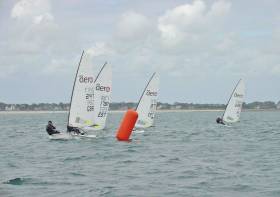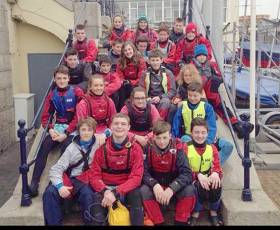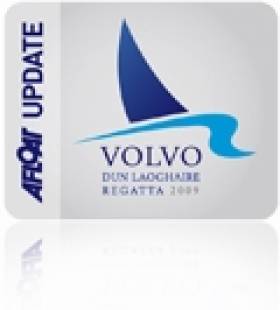Displaying items by tag: Royal St George YC
Sean Craig Finishes Seventh At RS Aero Worlds
#RSAero - It’s a seventh-place finish for Sean Craig in the Aero 7 at the Rooster RS Aero Worlds in France.
After a gruelling 15 races over five days, the third discard kicked in – allowing Germany’s Marcus Walther and Britain’s Ben Rolfe to knock Ireland’s lone entry in the new ultralight class two spots down the table.
But the Royal St George YC sailor maintained his consistent performance despite the persisting breeze during the week at Carnac, where wind speeds never dipped below 15 knots.
Higher up the table, the battle for first was won by Steve Cockerill over his fellow Briton, and RS class brand manager, Peter Barton.
Sean Craig Fifth After Nine Races At RS Aero Worlds
#RSAero - Sean Craig, Ireland’s lone entry in the Rooster RS Aero Worlds, is currently in fifth place in the Aero 7 division after three days of racing at the Yacht Club de Carnac in France.
As of yesterday evening (Wednesday 26 July), the Royal St George sailor and former RS200 Irish champion is nine races into the competition and showing consistent performance despite the fresh conditions, with strong winds between 15 and 25 knots since Monday (24 July).
The top of the table, meanwhile, remains a battle between Britain’s Steve Cockerill and Peter Barton, brand manager of the RS class.
Launched three years ago, the ultralight RS Aero had its first happy Irish customer in Daniel McNeills of the Royal St George — and also received high praise from Dun Laoghaire’s young Olympic Laser contender Finn Lynch.
Royal St. George YC Hosts RS Feva Easter Clinic 2016
The RS Feva class had a really successful training clinic over the Easter holidays, with 26 sailors taking part over the 3 days. Led by our National coach, Stephen Craig, assisted by Meg Tyrrell, we had great pleasure in welcoming sailors from Galway, Malahide and Greystones as well as those from the RSGYC and NYC. It was great to see so many new faces coming in to the class this year writes Elaine Malcolm
On the Sunday we started the day with some ice breakers and a rigging session, where everyone participated in rigging a Feva from scratch. We launched soon after and began with a warmup inside the harbour, before heading outside the harbour where we did upwind exercises with focus on pointing and lane holding. Tacking on the whistle allowed us to coach each sailor individually from our RIBs as they sailed upwind. We followed by doing long downwind grinds with focus on efficient hoists and drops. Conditions were light to moderate.
On Monday conditions were lighter still, although in the morning we managed to get in some upwind training with a focus on roll tacking and boat balance, with an improvement in both of these aspects. When the wind did drop to virtually 0 knots halfway through our session, we carried out games to keep the sailors entertained for the remainder of the water session.
On Tuesday we started off with about 0-2 knots, and so we planned for a day with very little breeze. We launched and did some fun races and games, however halfway through our session the wind filled in to about 7 knots and we managed to cover some upwind practice followed by downwind training. We put a focus on angles when sailing downwind and how to sail the best possible course. We then ended the day with a session on starts and how to find the bias, followed by races. When we returned ashore there was pizza waiting for the sailors as a very welcome way to end the clinic.
ISORA Sailors Set Sail for Isle of Man Offshore Weekend
#isora – No sooner is last night's DBSC racing over than some round–the–cans regulars are venturing outside the Bay this evening on a two–race ISORA weekend, with the Isle of Man as the focus. As David O'Brien reports in this morning's Irish Times Sailing Column the overall leader and defending champion Ruth (Liam Shanahan) has claimed a five point lead going into tonight's fourth race that has attracted a bumper fleet of over 20 that sees the focus of Irish sailing heading offshore this weekend.
The first race is tonight's 60–mile race four in the ISORA series from Holyhead in North Wales to the Isle of Man followed on Sunday by race five's 100–miler from the Manx port to Dun Laoghaire starting early at 0630 hours.
Overall, Shanahan's J109 from the National Yacht Club (NYC) leads Adrian Lee's Cookson 50 Lee Overlay Partners of the Royal St. George YC. The Pwllheli–based J109, Mojito is third. J boats occupy four of the top six places after three races and this weekend's forecast may also play into J hands.
As of this morning, the course for each race is likely to be direct from start to finish with light winds on offer and upwind a lot of upwind sailing predicted. This year's Avery–Crest sponsored series has the added attraction of satellite tracking that plots each competitors course, giving an extra dimension for race followers.
DLDinghies Initiative Unveiled at Royal St. George Dinghy Summit
#dinghy – Spinning out of the first Royal St. George YC Dinghy Summit last Saturday in Dun Laoghaire a further initiative for Dublin Bay Sailing Club (DBSC) dinghy sailors was unveiled.
The DBSC Portsmouth Yardstick (PY) Dinghy committee is working hard to promote dinghy sailing on the Bay and has kicked off a number of initiatives which they hope will bear fruit over the rest of the year.
The committee, lead by David Dwyer, has a number of goals; to make dinghy sailing more accessible welcoming and social, to get more coaching and more fun into the regular sailing and to improve communications to the sailors and to the media. Some of their initial efforts are online and they're easy to find. Click for DLDinghies.
Perhaps the key effort is to get more people into the fleet, including juniors, new sailors, and the many "lapsed" sailors out there - both male and female.
Afloat.ie would like to hear from you on this story! Your comments are welcome in the box below
Sign up for our weekly Afloat.ie newsletter here, follow us on twitter @afloatmagazine or like us on Facebook
100 Boats Sailing in for July's Dun Laoghaire Regatta
Royal Cork's Anthony O'Leary, Afloat.ie's Sailor of the Year, is an early entry for July's Volvo Dun Laoghaire Regatta that has already attracted 100 entries, 50% of which are come from outside the Dublin Bay area.
The hope is O'Leary (who will be sailing Antix Beag) will be joined by a Crosshaven club mate Conor Phelan (sailing Jump), both are previous cruiser class winners in the 17-division championships that starts this year on July 7.
The biennial event, hosted by all four waterfront clubs, prides itself as Ireland's biggest sailing event. Seven nations and 32 yacht clubs are represented. So far 14 clubs are coming from England, two from Scotland, two from Wales, one from the Isle of Man and one from France.
The massive event that is expecting up to 500 entires is chaired this time by local sportsboat sailor Adam Winkelmann.
Dublin clubs have not been slow to enter early either. As expected Dun Laoghaire's own waterfront leads the way; The Royal Irish YC has 19, the National YC has 11, the Royal St George YC nine and the Dun Laoghaire Motor YC three entries.
An early entry discount is in operation for the next 28 days only. Enter here.Click this link for the latest Dun Laoghaire Regatta.
Join the Regatta on Afloat's facebook page here.
National Award for Irish Cruiser Racing Association (ICRA)
In the three decades and more of the Mitsubishi Motors/Irish Independent "Sailing Club of the Year" assessments, there has never been an organization only seven years old winning the title.
In fact, seniority has often won the day, though in a country in which the oldest sailing clubs date from 1720 (Royal Cork) and 1770 (Lough Derg), it's difficult to find clubs and associations which are anything less than centenarians, let alone not yet in double figures.
But it was only as recently as June 2003 that the Irish Cruiser Racing Association came into being. It was at the biennial Sovereign's Cup series in Kinsale that Fintan Cairns of Dun Laoghaire, enthusiastically supported by the late Jim Donegan of Cork and other key personnel, successfully launched the idea of a nationwide organisation to co-ordinate the racing sport of "boats with lids".
At the time, it was a leap of vision. Having successfully headed Dublin Bay Sailing Club at a time of rapid growth, he was able to see the picture more clearly than those who reckoned that offshore racing organisations should be related to bodies of water rather than a land mass, for all that we're on an island.
Then too, the new association was envisaged as using established clubs and their facilities to stage its championship. In other words, the ICRA organising team would be the travelling people of the Irish sailing scene. On top of that, handicap competition with cruiser-racers was derided as "truck racing" by the white hot one design and dinghy sailors.
Yet the idea took hold, and the annual championship was successfully staged at venues as various as Crosshaven, Tralee, Howth, Kinsale and Dun Laoghaire, with Denis Kiely the essential ace number-cruncher in the back office. And in May 2010, with the mighty machine of the Royal St George YC in Dun Laoghaire providing the administrative centre, the Liebherr Irish Cruiser Nationals in Dublin Bay attracted a fleet of 117 boats, with great sailing.
On that event alone, ICRA would have been among the front runners for Club of the Year. But the best was yet to come. In recessionary times, getting a three boat team together to make a worthwhile challenge for the biennial Rolex International Commodore's Cup was a matter of making the best of limited resources. But ICRA – currently under the leadership of Barry Rose of Cork - was up to the job.
The team of Anthony O'Leary's Antix, Dave Dwyer's marinerscove.ie, and Rob Davis and Andrew Creighton's Roxy 6, had a convincing win. Thus ICRA in one season had catered very well for general run of boats and crews at home, and had come out tops at the top level internationally. It doesn't get better than that, and we salute them as Sailing Club of the Year 2011.
Crew/Skipper Match-Making at RSGYC
The Royal St George is holding an event to match aspiring crews with crew-seeking skippers tomorrow (Tuesday July 6) at 7.30.
The Crew Match Party is an evening for owners/skippers to meet and recruit potential crew for the season. It's an opportunity for crew to make contact with owners and/or skippers, swap experiences and compare skills with other sailors.
Crew should bring along a copy of their sailing CV to hand out including contact details, and owners and skippers should have information on their yachts and their crew requirements
So, come along for a beer - or two! - and complimentary finger food on Tuesday, 6th July at 7.30pm.


































































